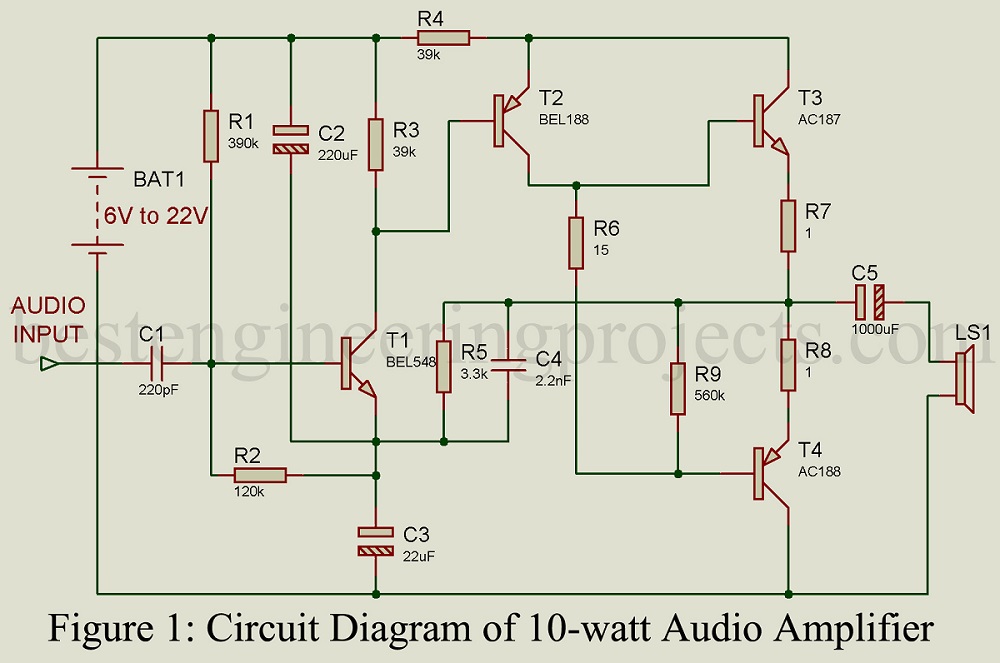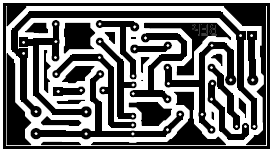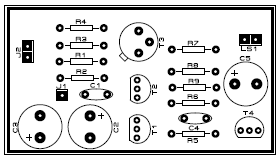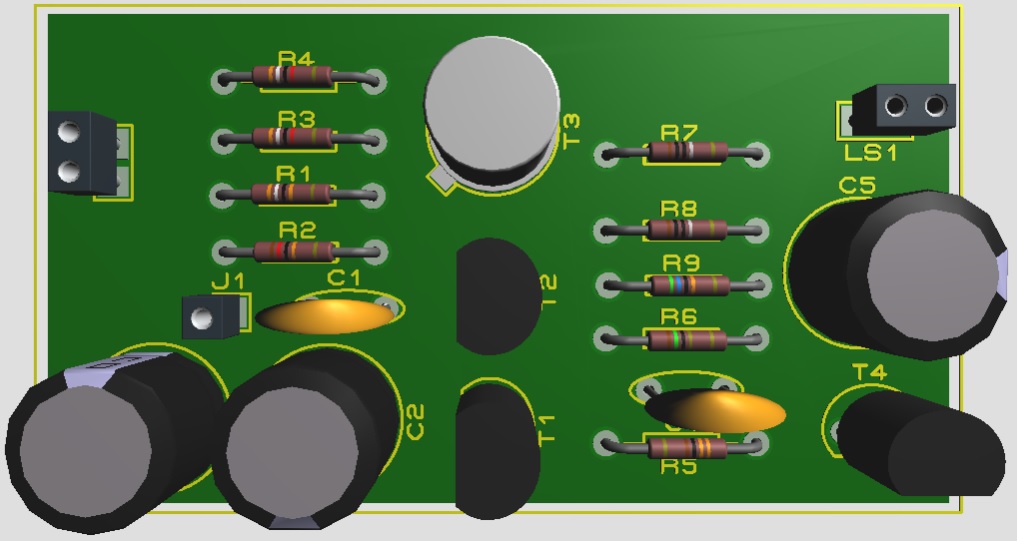The Driver Amplifier amplifies the weak electrical signal from the microphone and makes it suitable for power amplification. Thus, an amplifier that is used before a power amplifier is called a driver amplifier. As all amplifier driver amplifier is also a cascade amplifier. Thus, by cascading multiple amplifier stages a project 10-Watt Audio Amplifier is built.
Circuit Description of 10-Watt Audio Amplifier
The project shown in figure 1 is of 10-Watt Audio Amplifier, which is basically a combination of various amplifiers i.e. pre-amplifier, driver amplifier, and a push-pull amplifier. Here in the project “10-Watt Audio Amplifier” transistor T1 act as a pre-amplifier, T2 as a driver amplifier, and transistors T3 with T4 as a push-pull amplifier.
The output of the microphone is given to the base of transistor T1 (Pre-amplifier) through coupling capacitor C1. The output of transistor T1 is available at the collector which is used to drive the driver amplifier. The driver amplifier amplifies the weak signal and makes it suitable for power amplification. The output of the driver amplifier is given to the base of the push-pull amplifier (T3 and T4). The output of the push-pull amplifier (transistors T3 and T4) is taken from the emitter through 1 resistor (resistors R7 and R8). The output is given to the speaker through coupling capacitor C5. Resistor R9 is a feedback resistor that is connected to the base of transistor T4.
Similarly, another feedback network is designed using resistor R5 and capacitor C4 which is connected to the emitter of pre-amplifier transistor T1. When a supply voltage of 22V is given to the circuit the power obtained at the output is 10W, which changes according to the supply voltage. As the supply voltage is low the power obtained at output also becomes less.
PCB Diagram:
PCB Diagram of 10 Watt Audio Amplifier is designed using Proteus 8.1. The actual size Solder side and Component side PCB diagram are shown below.
NOTE: Heat sink is required due to heating problem at power amplifier at the stage. So proper heat sink must be connected to the transistor T3 and T4.
Figure 4: Author prototype of 10 Watt Audio Amplifier
PARTS LIST OF 10-WATT AUDIO AMPLIFIER
| Resistors (all ¼-watt, ± 5% Carbon) |
| R1 = 390 KΩ
R2 = 120 KΩ R3, R4 = 39 KΩ R5 = 3.3 KΩ R6 = 15 Ω R7, R8 = 1 Ω R9 = 560 KΩ |
| Capacitors |
| C1 = 220 pF (Ceramic Disc)
C2 = 220 µF/16V (Electrolytic Capacitors) C3 = 22 µF/10V (Electrolytic Capacitors) C4 =2.2 nF (Ceramic Disc) C5 = 1000 µF/16V (Electrolytic Capacitors) |
| Semiconductors |
| T1 = BEL548 (NPN Transistor)
T2 = BE188 (PNP Transistor) T3 = AC187 (NPN Transistor) T4 = AC188 (PNP Transistor) |
| Miscellaneous |
| LS1 = Speaker |
Various other power amplifier circuits posted in bestengineerngprojects.com
- 3 Watt audio amplifier using AC187 and AC188 Pair
- 7 Watt audio amplifier using TBA810
- 8 watt + 8-watt Stereo Amplifier Circuit with Graphic Equalizer
- 20 Watt Audio Amplifier using TDA2003
- 20 Watt Audio Amplifier using TDA2020




Your circuit show no connections on T1 base, also 220pf too low for audio coupling. Wrong circuit.
Thank you Mr. Rahul for letting us know about connection, we had updated the circuit diagram with possible modification.
Now, the value used for coupling capacitor is enough for coupling, because the resistance (R3) across coupling capacitor is of large value. However, if the resistance is greater, such as 120KΩ, you can divide value of capacitor by 12; meaning you can use even a smaller capacitor. Thus for trade off between design and size we did so.
The circuit posted is 100% tested and verified.
Hi, I’ve seen this schematic for so long in various versions, and always it’s described as a 1 to 3 W amplifier; I think to know what I’m writting because I’ve been interested on making it but failed to get all the parts; I want to make a bit more complex to see how much the THD can be lowered, as the case with the bigger Amp brothers just because I think that a low power amp shouln’t be made as a toy, it must be capable of attain low THD and IMD figures and offer good sound too. Anyway thankyou for sharing this little germanium gems to those who doesn’t know of them.